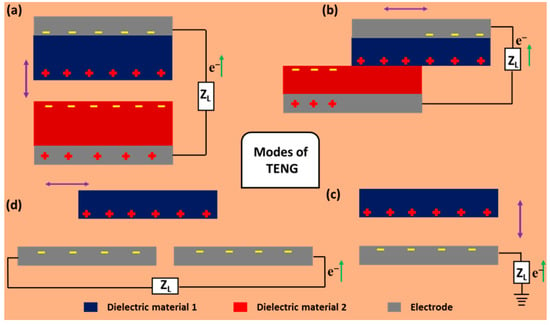You're using an outdated browser. Please upgrade to a modern browser for the best experience.
Please note this is a comparison between Version 1 by Tapas Kamilya and Version 2 by Catherine Yang.
The triboelectric nanogenerator (TENG) is a promising research topic for the conversion of mechanical to electrical energy and its application in different fields. Among the various applications, self-powered bio-medical sensing application has become popular. The selection of a wide variety of materials and the simple design of devices have made it attractive for the applications of real-time self-powered healthcare sensing systems.
- triboelectric nanogenerator
- self-powered sensor
- biomedical application
1. Introduction
The evolution of technology continues to miniaturize electronic gadgets from the time of the invention of semiconductor technology [1]. The electronic gadgets used daily are mostly battery-dependent for their power requirements [2][3][2,3]. The drawback of batteries comes under consideration of their limited lifetime, and they becomes environmental hazards after their expiry [4][5][6][4,5,6]. Furthermore, the inclusion of DC circuitry in a device makes it heavy and expensive [7][8][7,8]. The research on renewable energy technology continues to give promising alternative to the use of conventional energy-based electronic equipment [9][10][11][9,10,11]. Among the alternative energy sources, the solar cell possesses some advantages over others for alternative energy generation, and a lot of research is investigating this solution [12][13][14][12,13,14]. However, its main drawback is its dependency on sunlight. Due to clouds and rainy seasons, the yield of the solar cell degrades [15][16][17][15,16,17]. On the other hand, a lot of mechanical energy gets lost due to our daily activities, such as walking, running, vibrations, body movements, or cars passing, and by nature’s activities, such as wind flow and tides [18][19][18,19]. To convert these mechanical energies to electrical energy, a lot of conversion techniques have been established by researchers, such as electrostatic, piezoelectric, electrochemical, and magnetostrictive methods [20][21][22][23][24][20,21,22,23,24]. To convert mechanical energy, the piezoelectric effect has shown a great contribution, and a lot of research has been carried out and continues to be on it [25][26][25,26]. Currently, for scavenging mechanical energy, the triboelectric nanogenerator [TENG] has attracted the attention of the scientific community and plenty of research has continued into different applications for the technology, which was invented a decade ago by Z. L. Wang [27][28][29][30][31][32][33][34][35][27,28,29,30,31,32,33,34,35]. The main advantage of this energy scavenger is the choosing of diverse materials, since almost every material takes part in triboelectrification in contact with other materials, and they become positively and negatively charged [36][37][38][39][40][41][36,37,38,39,40,41]. The working mechanism of a triboelectric nanogenerator for the mechanical energy scavenging and its conversion to electrical energy is based on contact-electrification and the induction effect [27][28][27,28]. Until now, several reports have been published on the self-powered sensing and detection applications of TENG [27][42][43][44][45][46][27,42,43,44,45,46]. As there is no use of a battery for the power source and each material can show tribo-properties when using bio-friendly materials, people have developed a lot of self-powered bio-medical sensors using triboelectric nanogenerators [47][48][49][50][47,48,49,50]. Wearable electronics for bio-medical sensing applications using triboelectric nanogenerator is a promising field in futuristic gadgets for the healthcare sector [51][52][53][54][55][56][57][58][51,52,53,54,55,56,57,58]. There are two categories of TENG-based sensors or detectors used for healthcare monitoring; one is wearable devices, and another is implantable devices. Wearable TENGs are attached to different parts of the human body to obtain a source of mechanical energy from various kind of movements, such as stretching, squeezing, running and, simultaneously, they give the corresponding physiological signals [42][44][52][53][42,44,52,53]. On the other hand, bio-friendly and biocompatible materials are used to develop implantable devices to implant in human organ, such as the stomach or muscle to obtain the corresponding physiological signal of the body organs [49][59][60][49,59,60]. As TENG converts mechanical to electrical energy and human body movements can be a mechanical energy source, by using TENG fitted to human body we can obtain electrical energy and, simultaneously, the device can act in self-powered sensing applications. The biggest advantage of using TENG-based sensing systems for bio-medical application is that there is no use of an external power source; additionally, they are lightweight, have simple features, and are low-cost. However, there are some challenges, such as sensitivity for very weak forces, and stability of performance over various ambient conditions.
2. Fundamentals of TENG
2.1. Vertical Contact-Separation (C-S) Mode
This mode is the widely applied mode for developing TENG configurations, as it is easy to fabricate and straightforward, as shown in Figure 1a. The working principle is as follows: when two different materials with attached electrodes comes into contact with each other under the presence of external force, they produce a surface charge depending on their electron affinity. When the two charged surface starts to separate, an electrical potential develops, which induces the opposite kind of charges on the surface of the electrodes. This induction of charges comes from the transfer of electrons from one electrode to the other electrode. During the approach, the potential difference tries to minimize and the direction of flow of the electrons becomes opposite to the case of the separation. Hence, in this way, we obtain alternating current at the output [38][69][70][38,69,70].
Figure 1. Different modes of TENG. (a) Vertical contact-separation (CS) mode. (b) Lateral sliding (LS) mode. (c) Single electrode (SE) mode. (d) Freestanding triboelectric (FST) mode.
